Government Intervention of Microeconomy Methods
1/47
Earn XP
Description and Tags
Taxes subsidies, max min prices, buffer stocks,
Name | Mastery | Learn | Test | Matching | Spaced |
|---|
No study sessions yet.
48 Terms
What are the ways (5) that the government can intervene in a market?
Taxes and Subsidies
Maximum and minimum prices
Direct provision of public goods
Buffer stock schemes
Direct provision of information
What problems do taxes and subsidies solve?
Taxes can tackle overconsumption of demerit goods
Subsides can tackle underconsumption of merit goods.
What problems do maximum and minimum prices solve?
Maximum prices are supposed to protect consumers. E.g. rental.
Minimum prices are supposed to protect “producers”. E.g. minimum wages.
What problem does the direct provision of public goods solve?
The lack of public goods due to the free rider problem.
What problem does a buffer stock scheme solve?
Volatility. So that prices can be stable.
What problem does the direct provision of information solve?
Imperfect information
What is market failure?
When an unregulated price mechanism fails to allocate resources to achieve the best outcome for society, i.e. the socially optimal allocation of resources.
This is opposite to allocative efficiency.
When does market failure happen?
When there is:
Underallocation (which can happen with merit goods.
Overallocation (which can happen with demerit goods).
And no allocation (which can happen with the non provision of piblic goods.)
What is the free rider problem?
The free rider problem is something that arises with the provision of public goods in market economies. It is the problem that arises with the non-excludability of public goods.
Firms cannot prevent non-payers from enjoying the good, so it is impossible to charge a price on its use, as no one will want to pay for it.
What problem does the non-rival quality of public goods pose in market economies?
The good doesnt diminish with consumption. This means if a company sold one public good to one person, other people who didn’t pay for it can also enjoy it, so the marginal cost for the good is zero, and firms can only charge zero for such a good, but no firm will want to supply the good then.
How to think about the problems of non-rivalry and non-excludability of public goods in market economies
Non-rivalry: consequence is only price can be charged is 0, so firms dont want to supply it.
Non-excludability: free rider probelm, consequence is consumers dont have to pay for it, so consumers wont want to pay for it.
Refer to previous flash cards for more detail.
How can overconsumption of demerit goods be displayed on a graph?
There will be 2 demand curves. The percieved Marginal Social Benefit (right) and the true Marginal Social Benefit (left).
The quantity demanded is too much. The shaded region represents how much people are overpaying for the good (The deadweight loss)
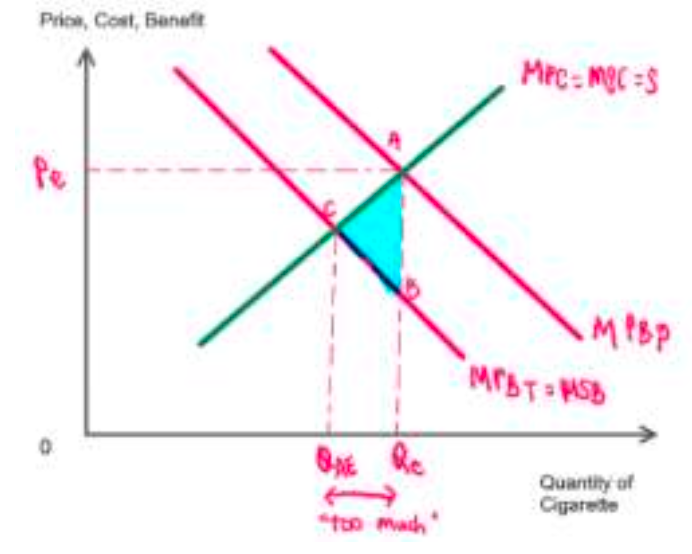
How can underconsumption of merit goods be displayed on a graph?
There will be 2 demand curves. The percieved Marginal Social Benefit (left) and the true Marginal Social Benefit (right).
The quantity demanded is too little. The shaded region represents how much people are underpaying for the good, or how much society stands to gain.(The deadweight loss)
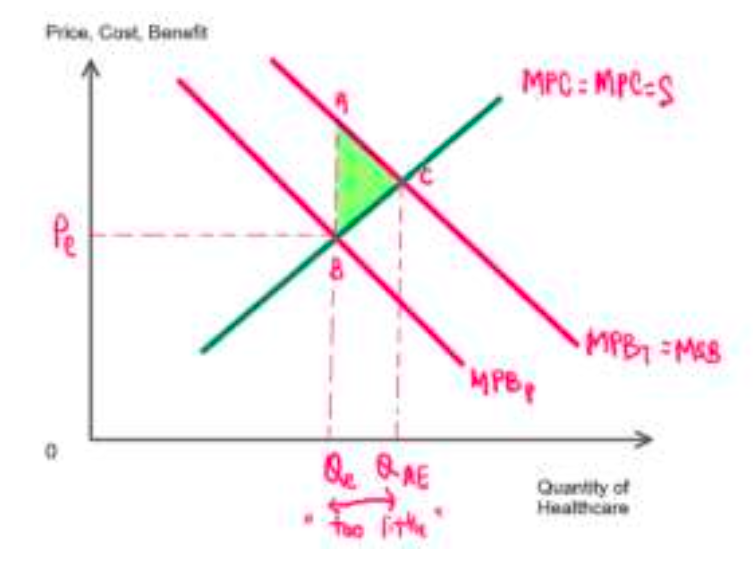
What are indirect taxes?
Taxes levied not directly on the individual, perhaps through income, but on expenditure on goods or services. Paid through the sellers
what are direct taxes?
Taxes that are levied on the individual, perhaps through income.
Specific taxes vs ad valorem taxes.
Specific taxes apply a fixed amount of tax per unit good.
Ad valorem taxes apply a taxes a percentage of expenditure. The more you spend, the more you pay.
How does an indirect tax affect the market and how can it be illustrated on a graph?
When an indirect tax is levied on a good, the cost or production increases. As such, the supply curve will shift up by the amount of tax that is levied (hence the curve can also be said to shift left). The equilibrium price will rise. Quantity demanded will decrease.
Dont worry about incidence of tax. The flashcard will come.
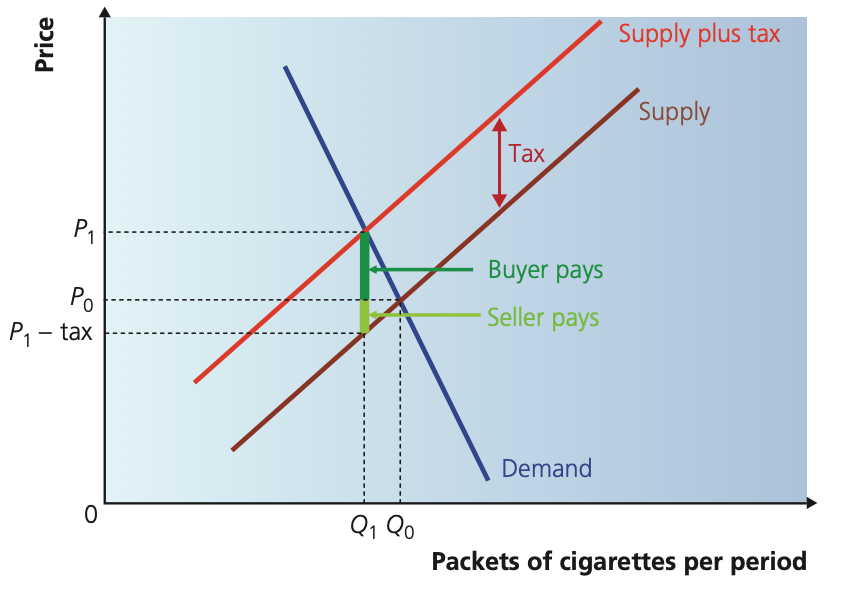
What is the incidence of tax?
How can it be calculated?
The incidence of tax refers to where the burden of an indirect tax is situated, on producers or consumers.
Incidence of tax is related to PED and PES. The more elastic one is relative to the other will pay less tax.
PES/PED = Tax on Producers/Tax on Consumers
How can the incidence of tax be displayed on a graph?
Note the new equilibrium price. The difference between the new price and the old price will be the amount of tax that falls on the consumer.
Take the magnitude of tax and subtract the tax paid by the consumer will give you the tax that falls on the producer.
You can hence see how the incidence of tax relies on the relative gradients of the two curves. You can also see that the producers will ofc try their best to pass the tax on to consumers. But all of this is due to market forces.
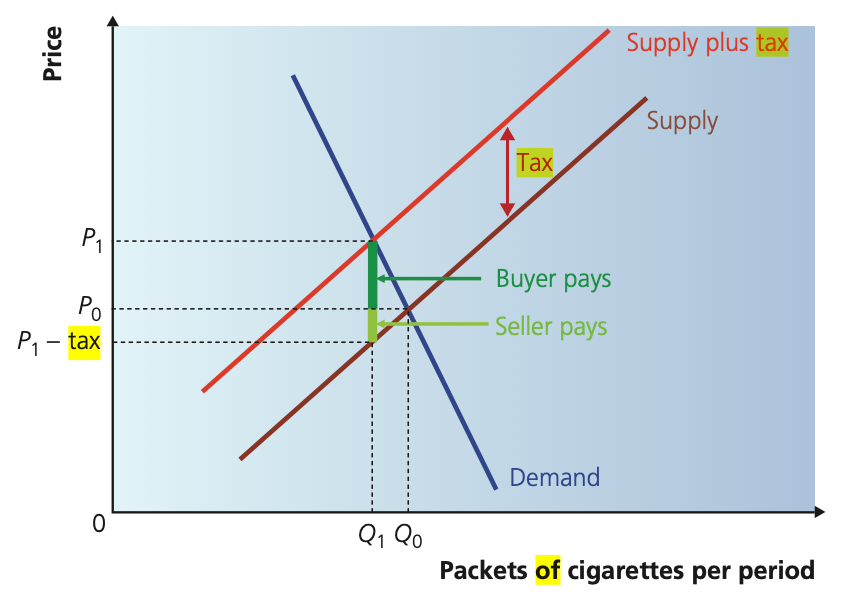
How can we read the tax revenue from a graph?
Multiply the amount of tax (vertical distance between the old and new supply curves) and the new quantity demanded.
You can also see the total incidence of tax as well.
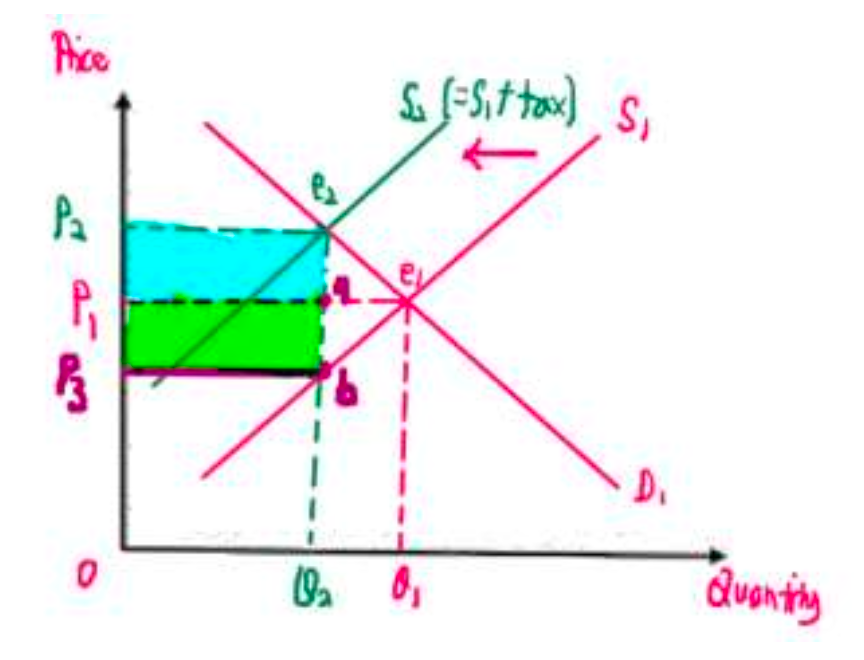
Where are the CS and the PS after taxes?
What is Total Social Surplus before and after tax?
Where is the deadweight loss due to the tax?
After tax, both CS and PS should decrease.
Total social surplus is the sum of the CS, PS, and Government Tax revenue.
Take the total social surplus before taxes and subtract the total social surplus after taxes you get the deadweight loss (Try it yourself!) represented in the little triangle.
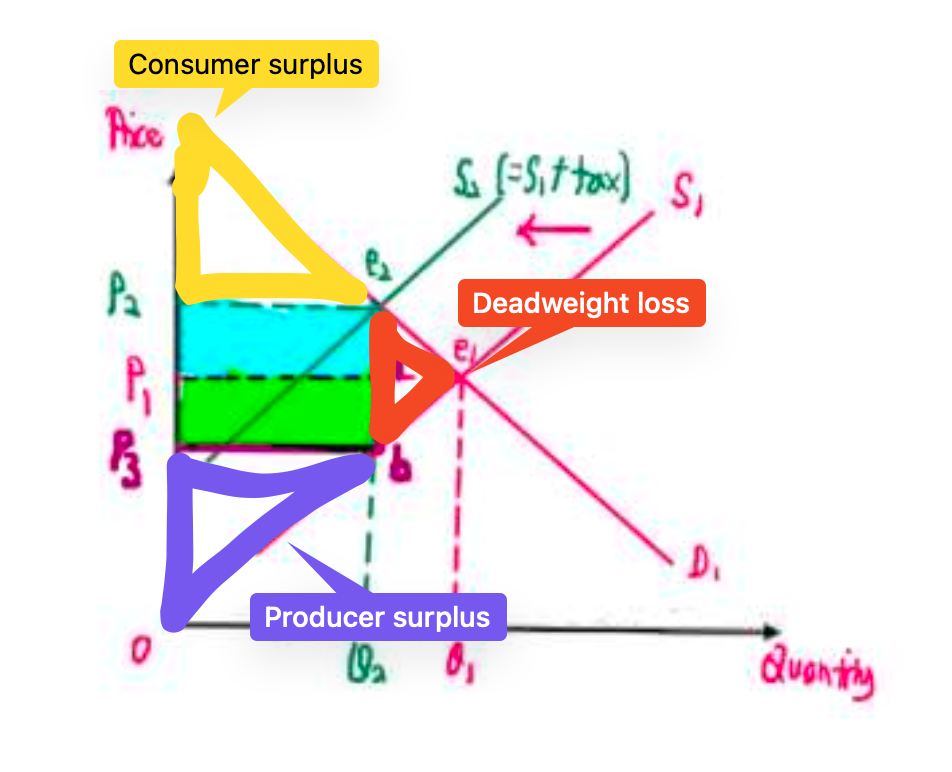
What is a deadweight loss?
A loss in social welfare. Market is inefficient and away from optimum due to any factors.
How do you read total revenue and net revenue after tax?
Look at the new price and new quantity demanded. Multiply them to get total revenue.
Net revenue is revenue after taxes. So subtract the area from tax revenue.
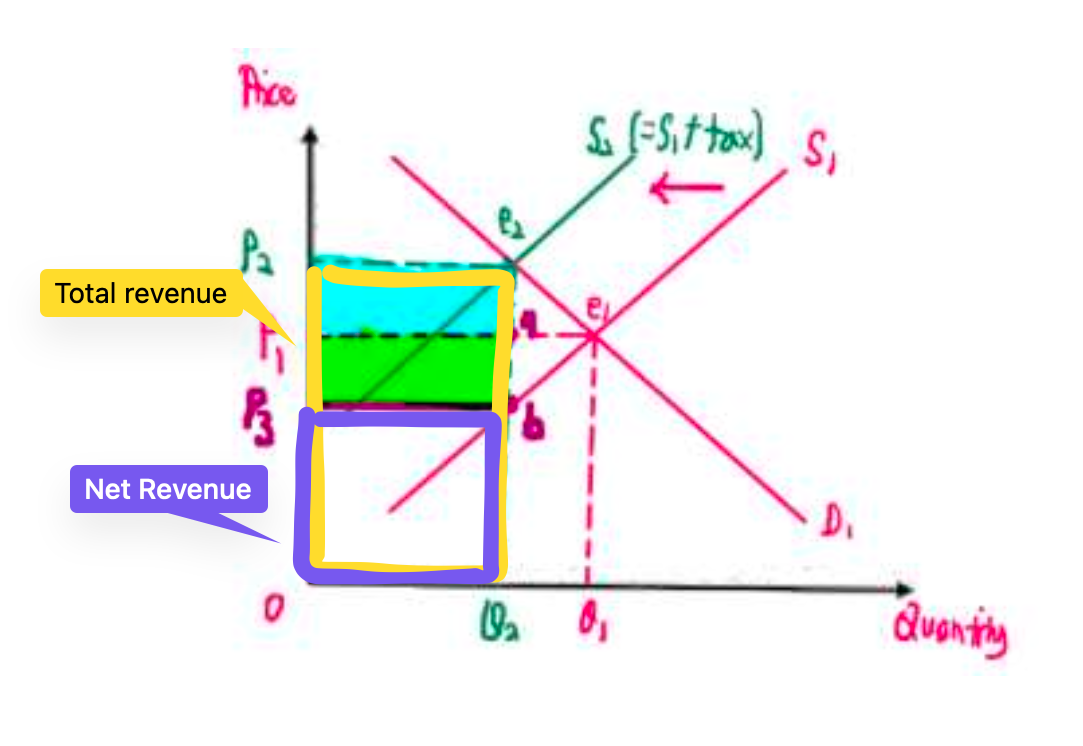
If the consumers (PED) are more elastic than producers (PES). Who will pay more of the indirect tax?
Producers.
Think of it as a game of chicken. The more elastic you are, the more quickly you will “chicken out” with price changes, forcing the other person to pay the tax. More elastic, pay less tax. Less elastic, pay more tax.
Also helpful to think about gradients.

When will the consumers take the full burden of tax?
When PED = 0 Consumers super inelastic
Or when PES = ∞ Producers super elastic
Draw graph!
When will producers take full burden of tax?
When PES = 0 Producers super inelastic
Or when PED = ∞ Consumers super elastic
Draw graph!
Where can we read the incidence of subsidy on a graph? (Of a single price)
The difference between the old and new price is the subsidy enjoyed by the consumers.
Take that and subtract it from the amount of subsidy given to get the subsidy enjoyed by the producer.
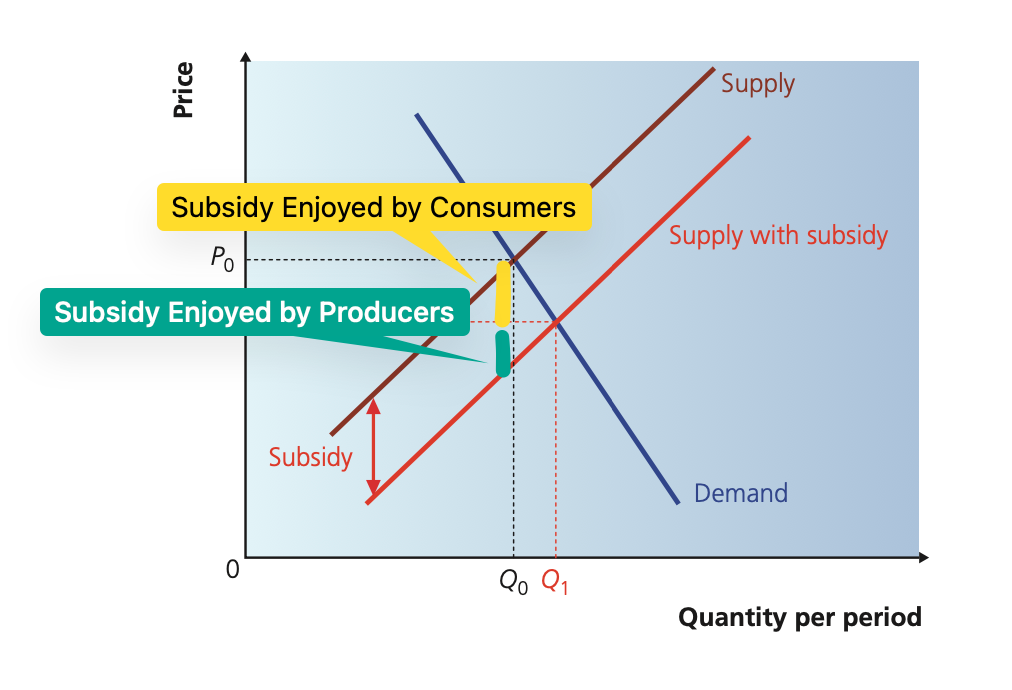
How to read how much the government is spending in subsidies?
Multiply the subsidy per unit with the new quantity demanded.
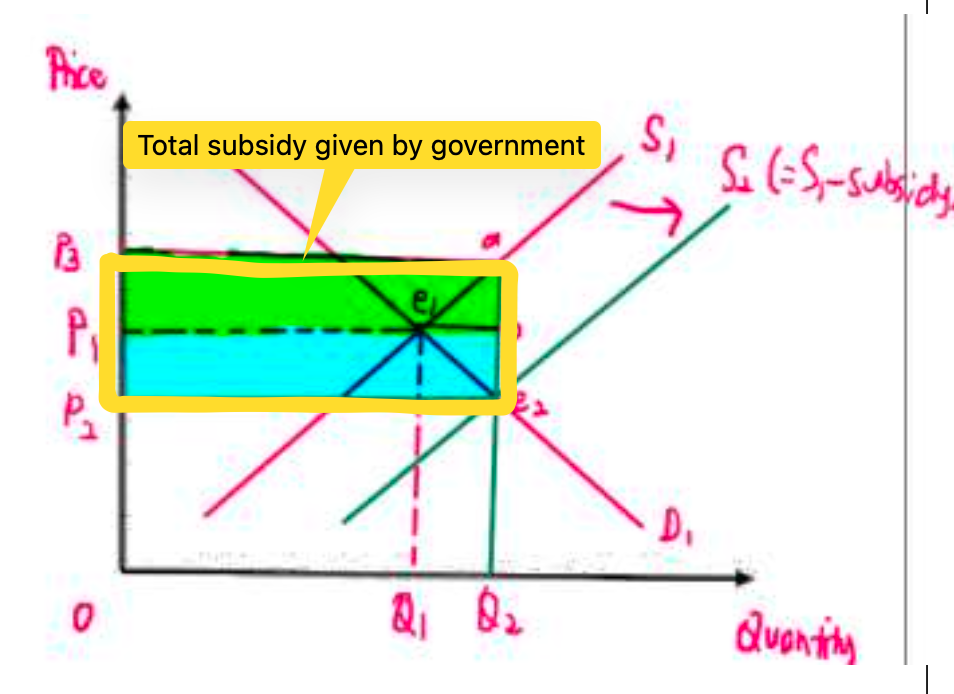
What happens to CS and PS after a subsidy?
What happens to total society surplus after a subsidy?
Where can we read the deadweight loss?
CS and PS will increase
Total Society Surplus will decrease. After you subtract the cost of the subsidy from the new CS + PS you will see that the govern will have to pay extra that is enjoyed by no one, represented by the area of the triangle.
Deadweight loss is the little triangle.
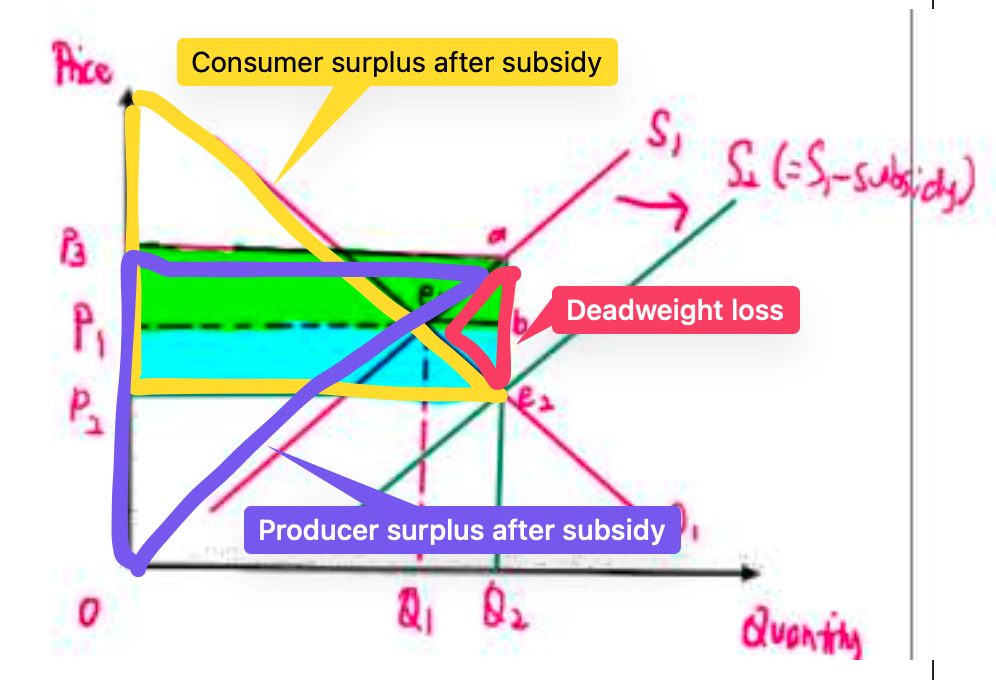
What determines the incidence of subsidy?
Relative elasticities of PES and PED.
The more inelastic PED is compared to PES, consumers enjoy less subsidy compared to producers
The more inelastic PES is compared to PES, producers enjoy less subsidy compared to producers.
Draw graphs and gradients!
Note: not strictly needed for A Levels
What are the chain of events that will happen when indirect taxes are removed?
Remove taxes, cost of production decreases, supply increases, price drop and quantity increase
What are the chain of events that will happen when subsidies are removed?
Remove subsidies, cost of production increases, supply decreases, prices rise and quantity decreases.
Downsides to indirect taxes
Indirect taxes tend to be regressive, (especially specific taxes) because it affects those with lower income more than those with higher income.
If taxes are used to reduce sale of demerit goods, it may not be completely effect if the good is addictive.
There will be a deadweight loss.
Downsides to subsidies
Subsidies incur an opportunity cost to the government. They cannot subsidise everything.
Subsidies may not be able to encourage the public to consume more of the merit good if the PED is ver inelastic, perhaps due to
there would be a deadweight loss.
What impacts does a maximum price impose on the market?
A price ceiling will cause a shortage in the market as demand will outstrip supply.
The rationing function of prices will fail, causing some people who are willing and able to buy the good to not be able to buy it because of the shortage. First come first serve or coupons might be used.
As such an illegal market may emerge.
There will be welfare loss due to inefficiency
What are maximum prices for?
They are typically used to protect consumers.
Example: price cap on essential goods and on rental
what impacts does a minimum price impose on the market?
A price floor will cause a surplus in the market as supply will become more than demand.
The surplus will have to be dealt with. Either they are destroyed or the governments sells them elsewhere. Such policies can burden the taxpayer.
As such an illegal market may emerge.
There will be welfare loss due to inefficiency
what are minimum prices for?
To protect the producers.
Example: minimum wage.
How do you represent a ceiling price on a graph?
A line below equilibirum price.
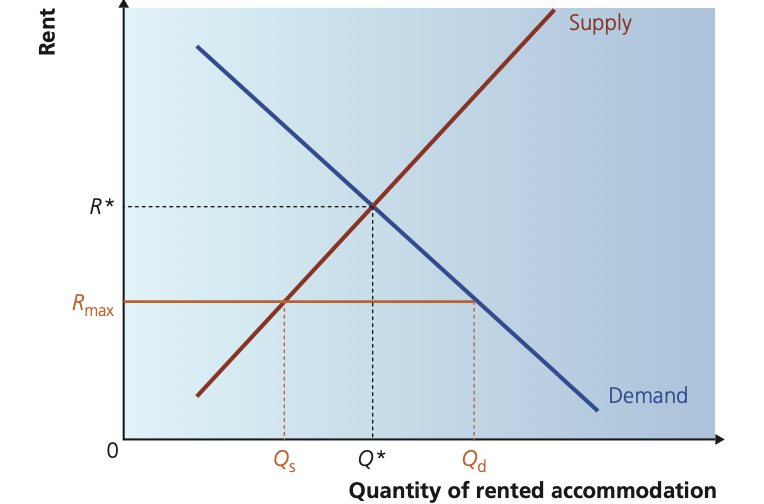
How do you represent a floor price on a graph?
A line above equilibrium price.

Which regions of in a graph that shows a price ceiling or a price floor represent the black/illegal market?
For price ceiling, everything that is above the price ceiling is illegal.
For price floor, everything that is below the price floor is illegal.
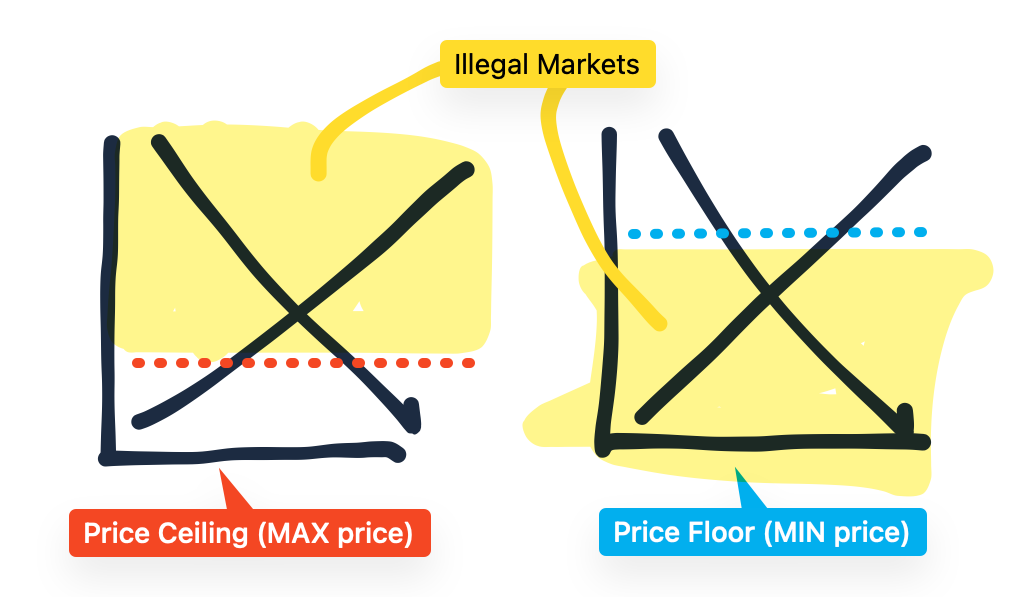
What are the downsides of a minimum wage?
Imposing a minimum wage can cause existing workers to be laid off, and an oversupply in the labour market, potentially causing unemployment.
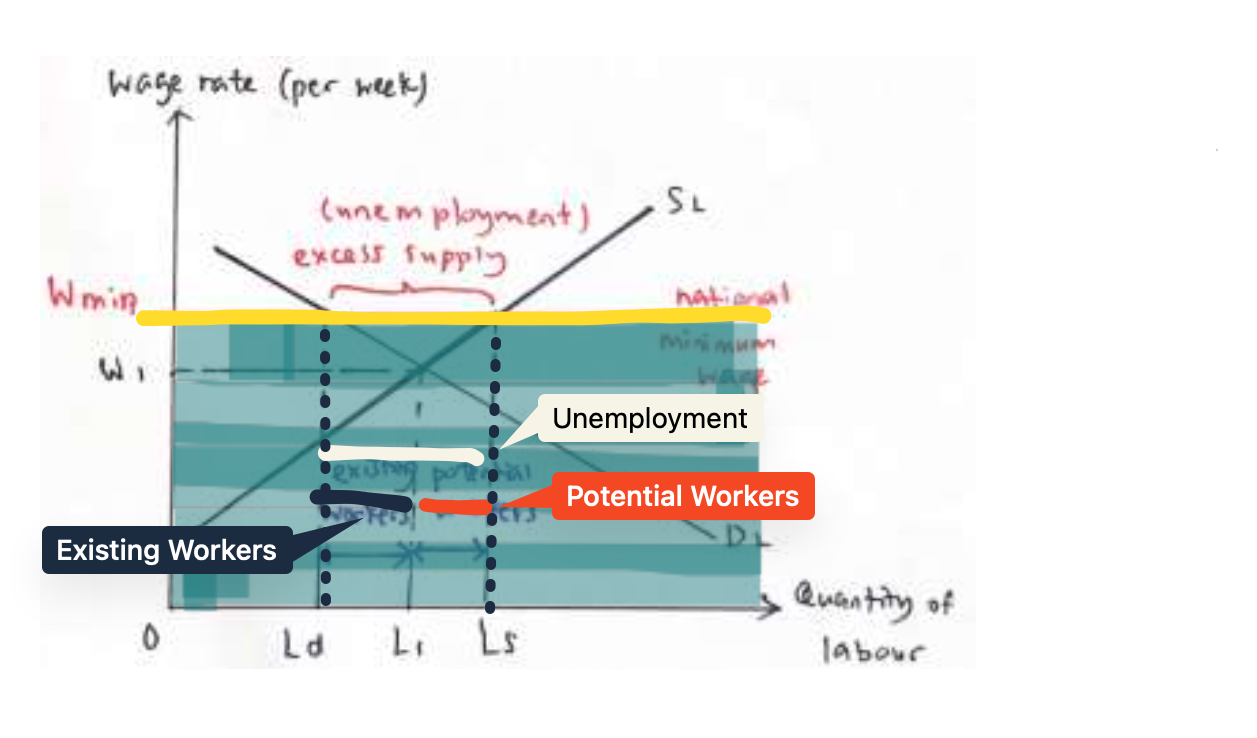
What are the downsides of a rent cap?
Imposing a rent cap can cause the supply of houses to let to drop, leading to shortage on housing, which is not good for the renter.
What is a buffer stock scheme?
A buffer stock scheme is where the government buys up extra stock when there is excess supply and sells the extra stock when there is a shortage. This is to prevent prices from fluctuating from too much due to fluctuations of demand or fluctuation of price.
How do you illustrate a buffer stock scheme on a graph?
To illustrate a buffer stock scheme designed to combat supply volatility, draw the normal supply and demand, then draw two other supply curves to show poor supply and good supply.
To illustrate a buffer stock scheme designed to combat demand volatility, draw the normal supply and demand, then draw two other demand curves to show poor demand and good demand.
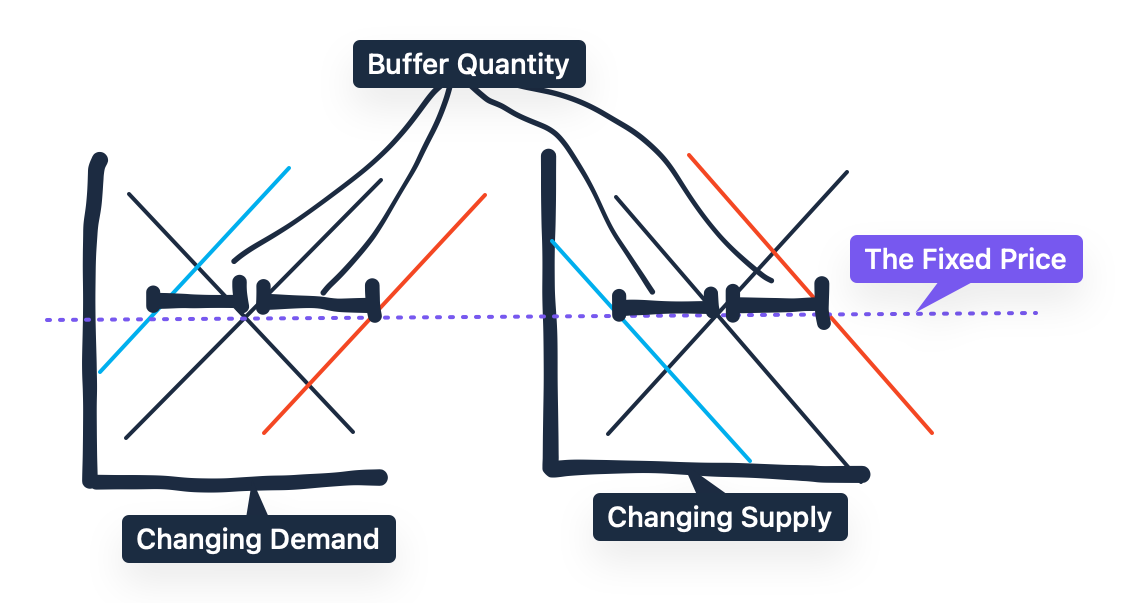
What are the advantages to a buffer stock scheme?
Ensures price stability.
Income to producers is more stable.
Which will allow producers to better make future plans.
what are the disadvantages to a buffer stock scheme? Please also think about how to illustrate the scheme on a graph.
1) The scheme is not effective for goods that are perishable/poor stockability
2) Such a scheme will incur costs
Lets only investigate changing supply,
3) If there is a series of good/bad supply, the scheme will get unsustainable.
4) Government will have to decide on an equilibrium price, and it is difficult to do so as the real market demand and supply is masked by the scheme. Setting the wrong price has consequences:
If the set price is too low, the government will will be buying more during good supply and selling less during bad supply. Long term it is not sustainable and will incur costs (overstock)
If the set price is too high, the government will be buying less during good supply and selling too much during the bad supply. Long term the buffer stock will run out and scheme is again, not sustainable. (understock)
5) Will have to involve majority of the producers to be effective.
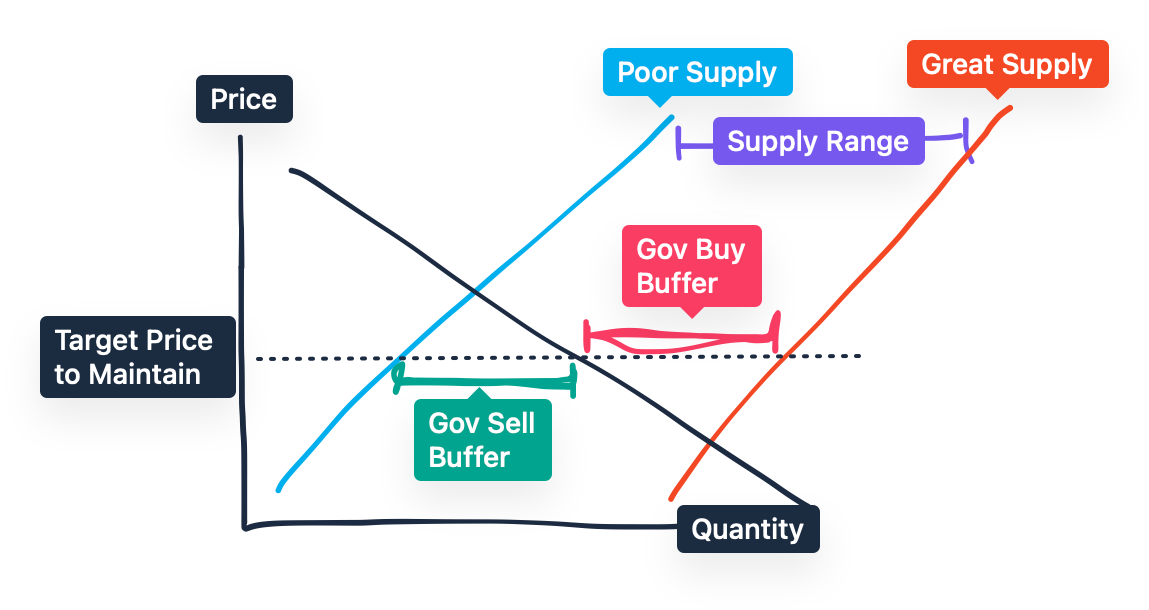
What are some limitation of direct provision of information?
Educational campaigns incur costs
People are not always receptive to these campaigns (smokers etc)
People can get desensitised by the campaigns in the long term
Such an effort is a long term project.